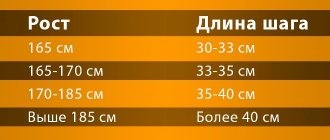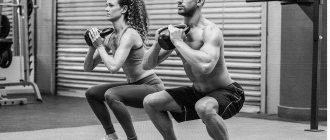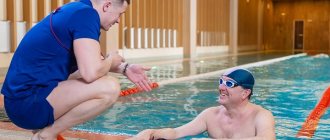For high-quality fat burning and maintaining muscle mass, you need to learn how to properly perform cardio training. Such loads help not only bring physical fitness back to normal, but also improve health. Let's find out what the essence of such training is, how they are useful and how to do cardio exercise correctly.
What is cardio exercise?
Cardio training is a load aimed at increasing endurance, which strengthens the heart muscle and improves the function of the cardiorespiratory system (blood circulation and breathing). During such activities, the body uses glycogen from the liver and subcutaneous fat as an energy source. With the right loads, training is very effective in the fight against extra pounds. This type of load increases the body's endurance.
What are they needed for
First of all, under such loads the cardiovascular system is strengthened: blood circulation improves, the heart muscle and blood vessels are strengthened. Cardio exercise is a good prevention of heart disease, respiratory dysfunction, and vegetative-vascular dystonia.
Benefits and disadvantages
Cardio training normalizes blood pressure, but with hypertension, you still need to be careful not to increase your blood pressure to a critical state. The main thing is to constantly measure your blood pressure before training and monitor your heart rate during cardio exercise.
What does cardio training give - advantages:
Increased stamina
Cardio training helps develop speed endurance when running, walking, or exercising on elliptical trainers. With increased endurance, the body is able to perform the load longer without getting tired for a long time. Developing endurance is very important when losing weight, since prolonged exercise will help burn the maximum amount of energy, and therefore subcutaneous fat.
Strengthening the cardiovascular system
By increasing blood circulation and blood volume, such loads can strengthen the heart muscle. This leads to improved vascular elasticity. Many people feel dizzy when doing exercises, this indicates vasoconstriction. Cardio training will help get rid of this. If you exercise for a long time, such symptoms will not occur.
Fat Burning
An increase in heart rate allows the body to expend more energy. First, the body uses glycogen from the liver for energy, and after 20 minutes, it switches to burning subcutaneous fat.
Disadvantages of Cardio
For more than half a century, cardio has been considered the best way to increase endurance and improve cardiovascular function. There is also an established opinion that aerobic exercise is the most effective for fat burning. In many ways, this belief was facilitated by the total passion for aerobics, shaping and step aerobics in the last three decades. However, this type of activity has many disadvantages.
- Strength training burns more calories. Any type of exercise generates calorie expenditure, and aerobic exercise is no exception. However, when working in an aerobic mode, the body's energy consumption increases only for the duration of the exercise, while during strength training this effect is prolonged and lasts several hours. For rapid weight loss, strength training is more effective.
- The main side effect of aerobic exercise is an increase in appetite immediately after exercise. This plays a huge role for those who want to lose excess weight. Aerobic exercise greatly exhausts the body. To “accelerate” your metabolism, you need to exercise for at least 20 minutes, because the fat burning process does not begin immediately. After such activity, the body tries to replenish energy losses, so appetite increases noticeably.
- Excessive increase in aerobic exercise negatively affects active muscle mass. Due to a lack of energy during training, the body does not “give up” fat, which in the future can be used to replenish energy losses, so the muscles suffer. To minimize this effect, it is necessary to approach the issue of proper nutrition very carefully.
Professional athletes consider cardio primarily as a way to increase endurance. Aerobic exercise is really beneficial, but only with the right approach.
What does cardio training include?
Cardio exercise can be anything, as it includes working both on cardio equipment and with your own weight.
These include:
- run;
- fast walk;
- cycling or doing exercises on the orbit track;
- stepper;
- treadmill;
- catamarans and other types of exercise bikes.
And also, it can be jumping rope, shuttle running, various jumping exercises, interval exercises.
General rules
Firstly, the body must be completely healthy, or you need to exercise under the supervision of a doctor or an experienced trainer.
Classes should be conducted outdoors or in a well-ventilated area , without the use of air heaters or air conditioning. Such devices burn oxygen, which is necessary for oxidative processes in the body.
The workout should not last more than an hour and the intensity should not exceed your training level. That is, beginners do not need to run 10 km/hour ; this will not benefit either health or weight loss.
Power training
By strength we mean high-repetition training with your own weight, training with weights of various types. During strength training, energy consumption occurs anaerobically, i.e. without the participation of oxygen.
Accordingly, fat oxidation does not occur, but lactic acid is formed. Therefore, strength training itself does not “burn up” fat, but strengthens and increases muscle fiber, which, in turn, leads to an increase in basal metabolic rate. The stronger and more massive the muscle fiber, the more energy is spent at rest.
| This is the main factor in reducing the percentage of fat mass from strength training: weight loss does not occur during training, but during recovery after it and in everyday life. |
So, strength training helps reduce body fat by increasing basal metabolism, but can lead to an increase in total body weight by increasing muscle fiber .
High Intensity Interval Training
HIIT is a kind of “arithmetic average” between cardio and strength training.
| This type of training, according to modern research, can provide an increase in physiological indicators in less time than long-term low-intensity exercise, and also have a positive effect on metabolism. |
Many studies indicate a higher level of fat oxidation, i.e.
about a more obvious “fat burning” effect of HIIT compared to aerobic training over the same time. HIIT is also an effective fat-burning workout because oxygen consumption (and therefore calorie burn) remains elevated after the workout .
This type of training puts extreme stress on the body and is suitable for trained people, so you should not practice it more than three times a week , especially since it is in this mode that the maximum effect is manifested.
So, HIIT helps you lose weight in a shorter period of time than other types of training, but this type of training is not suitable for everyone. You should not train in this way without preparation and more than 2-3 times a week.
Types and their effectiveness for burning fat
Walking
Even while walking, you can get rid of excess weight. In this case, walking should be fast enough. At a certain walking speed, your heart rate will increase and this will lead to weight loss. Such training should be long-term, since at a low speed, the heart will not receive enough load, and the fat burning process will not start.
Run
The most famous and accessible cardio workout is running. You can do it both in the gym and on the street. But even such a cardio load may not bring results if all conditions are not met.
When running, you must follow the correct technique, breathe correctly and accelerate without exceeding the upper threshold of the pulse zone. With such a load, it is important to take into account the level of training and health status.
Power loads
Strength training is not considered cardio exercise, but strength training can also help you lose weight, alternating it with running or jumping rope. On its own, strength training can burn fat if done as an endurance-building exercise with high repetitions. When choosing a strength regime, working to increase strength or mass, with a small number of repetitions, fat will be burned much more slowly.
Treadmill
A treadmill is a versatile cardio machine that you can use for running and walking. You can also alternate treadmill running with strength exercises, or perform acceleration and rest intervals. Any professional line of treadmills has an incline function. You can set the required angle of inclination, simulating an uphill climb. When bending over, the load increases, the gluteal muscles and the back of the thigh are more involved.
Static exercises
Static exercises are performed using slow (short) muscle fibers, and when running or endurance training, fast (long) fibers are activated. Therefore, static exercises can be considered less effective due to the physiology of the body.
An example of cardio training for burning fat without jumping and running at home - video.
Circuit training
Circuit training is more related to strength training, but by including cardio exercises in the complex, you can achieve results faster. For example, after doing squats, you can immediately switch to jumping rope. Or run 400 meters after doing abdominal exercises. There are many options, the main thing is that the load is constant, without long breaks.
Interval Cardio
Interval cardo is a type of load in which the difficulty level changes periodically. This load can be performed on a treadmill or other cardio equipment. Interval training can be set automatically in the simulator settings, and you can select the degree of load, indicating your weight, gender and age. The simulator itself will set the appropriate mode.
The optimal duration of classes is 30 - 40 minutes . You can independently control the intervals, speeding up and slowing down the pace after a certain period of time. Such exercises increase the body's endurance, thanks to changes in load, and make it possible to restore strength without reducing the effectiveness of fat burning.
Elliptical trainer
An elliptical trainer is also known as an orbitrack. The simulator simulates skiing. The mechanics are adjusted so that the joints and spine do not experience stress. Therefore, the exercise machine is approved for recovery from injuries, unlike a treadmill, since when running, the vertebrae and joints are subject to severe compression. By choosing a sufficient pace and load, the simulator will be quite effective for losing weight.
Types of Cardio Training
The most common cardio workouts that can be practiced even outside the gym are:
- walking;
- run;
- jumping rope;
- skis;
- swimming.
In fitness centers, such loads include exercises on certain types of exercise equipment (steppers, ellipses, bicycles and others), aerobics, dancing, circuit and interval intensive exercises, team sports (tennis, football and volleyball).
Walking
A natural type of activity for everyone, suitable for people with heart disease and obesity. Walking is also recommended when exercising during the rehabilitation period after injuries. In addition, this is a good solution for beginners in sports and those who cannot find time for training. Unlike running, movements do not put a lot of stress on the body, in particular on the joints, spine and muscles.
It is advisable to practice walking daily, alternating fast steps with regular ones. They should be frequent and short, since wide movements of the legs can cause pain in the hips and feet. When walking uphill, your exercise efficiency increases, which helps you burn more calories. Nordic walking and movements on an inclined treadmill show excellent results in health improvement.
So, in order to get the same calorie expenditure when replacing running with walking, you need to spend approximately 2 times more time. For example, 40 minutes of cross-country is equivalent to 80 minutes of walking at an accelerated pace (150 steps/min).
Run
Jogging is an effective and simple cardio workout that will boost your energy and burn a lot of calories. Moreover, such activity is equally useful both on the street and in the gym, and the intensity will depend on the state of health. Contraindications for running include knee problems and excess weight.
Long-lasting and quick results will be achieved by running at medium speed for 1 hour, 3-5 times a week. Beginners are advised to start with 10 minutes a day, adding 120-180 extra seconds each session. You can train for 20 minutes, but in this case you need to take walking breaks. In addition, while jogging, it is important to monitor your breathing and pulse. If your health is not ideal, then before starting exercise it is better to consult a doctor so that he can select the intensity of movements.
Swimming
In just an hour of swimming in the pool you can burn 600 kcal. This type of cardio does not load the spine and joints, but uses a large number of muscles at a fairly moderate intensity. Continuous movement in water increases the volume of the lungs, which improves the supply of oxygen to the body and increases blood circulation. In addition, swimming does not release the same amount of lactic acid as training on land.
Successful burning of fat and pumping muscles will be ensured by attending water classes regularly 3-4 times a week. During training, you should combine the use of different styles and movement in the pool at a fast pace. The processes will become even more effective if you practice under the guidance of an experienced trainer. Instructors at the La Salute fitness club prepare an individual cardio program for each client, adjusting the load to lead even a beginner to an ideal result.
Bike
The advantage of cycling is that there is no shock load on the joints and bones. Cardio training burns about 550 kcal per hour, “dries out” the leg muscles and is suitable for both beginners and more advanced athletes. The result is ensured by riding 3 times a week for 30 minutes. Moreover, exercising on an exercise bike in the gym is not inferior to pedaling on the street in terms of load efficiency.
Exercise equipment
Working on such equipment simulates running, walking, rowing, cycling and other types of training. The movements pump up almost all muscle groups and, if desired, provide high intensity, but at the same time put minimal stress on the joints. In addition, the exercise machines can always be programmed to control your stay in the cardio zone. Also, when exercising in the gym, it is easier to exercise under the supervision of a trainer.
Aerobics
A mix of elements accompanied by energetic music not only strengthens your overall physical condition, but also increases joint mobility, forms a muscle corset, and helps you lose weight. Exercise increases lung capacity and saturates tissues with oxygen. In addition, aerobic exercise calms the nervous system, counteracts stress and improves sleep.
The expected effectiveness is achieved only through regular exercise with a sufficient number of repetitions, performed at low or medium intensity. It is better to start with light training and increase the load gradually (by 10% per week).
Any combination of cardio activity or doing different types of exercise every other day is acceptable. This will pump up all muscle groups and make the body as developed as possible.
How to choose a load
Thanks to the functions of modern cardio equipment, the load is set automatically; it is enough to set the following parameters: gender, age, weight, exercise time and mode (interval, inclined walking, acceleration). If cardio training includes strength exercises and jumping, then you need to monitor your heart rate yourself. Pulse is the only indicator of the correct degree of exercise. The main thing is that it should not be lower than 120 beats/min, and not higher than 160.
How to Do Cardio to Burn Fat
Let's look at an example of interval training on a treadmill. It is advisable to have a bracelet that measures your pulse, or measure it yourself. We measure the heart rate for 10 seconds, multiply the resulting number by 6, we get the number of beats per minute.
Where to begin
Any workout should begin with a warm-up to prevent injury. We start with a slow walk, gradually speeding up the pace. Warm-up should last from 7 to 10 minutes. This time is enough for the muscles to warm up.
Intensity
After warming up, we accelerate, choosing the optimal running speed in the correct heart rate zone. After running 400 meters, we slow down the pace to a brisk walk, recovering for 3 minutes. After resting, we pick up the pace again and run another 400 m. We perform 4 laps in the same mode. At the end of the last circle, we restore the heartbeat while walking at a calm pace for 5 - 10 minutes. After the load, it is advisable to do some light muscle stretching.
What time should you exercise?
You can exercise at any convenient time: morning, afternoon, evening. Training should begin no earlier than an hour after eating. An effective method of combating excess weight is morning cardio on an empty stomach . Since the body has used up glycogen overnight, the body will use fat for energy in the morning.
In order not to destroy muscle protein, you can consume amino acids before training.
You can also do cardio in the evening, 2 – 3 hours before bedtime .
Frequency and duration of classes: how many times a week
One workout should not last less than 40 minutes. Since the body spends glycogen from the liver in the first 20 minutes, the remaining time will burn subcutaneous fat.
Therefore, it is advisable to spend the second part of the cardio workout at least 20 minutes .
Cardio exercise can last a maximum of 60 minutes . An overweight body can perform cardio exercises 5 times a week for 45 minutes , leaving 2 days for complete recovery. To maintain shape, weight and health, three workouts a week for 40-60 minutes are enough.
Heart rate and proper breathing
To burn fat, you need to use 60–80% of your maximum heart rate.
We consider the optimal heart rate: what should the pulse be for you:
- From 220 beats/min we subtract age and get our maximum.
- We multiply the number by 0.6 - we get the lower heart rate zone.
- Multiplying by 0.8 is the upper limit.
- We work within the zone of the obtained indicators.
Training does not make sense for fat burning if the heart rate is below the lower zone and also above the maximum norm.
Breathing should be chesty. Inhale sharply through your nose and exhale slowly through your mouth. When running, inhale as you step on your right foot. This will relieve pain in the side, since the liver will not be subject to pressure.
Cardio training - maintenance
Interval training
Treadmill training
- 45 seconds of fast walking, then 2 minutes of walking at an average speed. Do 5 sets, but gradually try to increase them to 7.
- Body part: Quadriceps Equipment: Exercise
Treadmill workout
- 4-5 minutes of slow walking.
- Body part: Quadriceps Equipment: Exercise
Treadmill workout
- 25 minutes of walking at an average speed. Gradually increase the time to 30 minutes.
- Body part: Quadriceps Equipment: Exercise
Add to Calendar * Add to My Workouts * Print Workout
* — The service is in beta testing
Examples of aerobic exercises for beginners
- Jumping rope – 300 times;
- Jumping on a bench – 4 sets of 20 times. We jump onto a hill with both feet at the same time. We lower our feet one by one to the floor;
- Long jump. We perform the maximum jump forward, and also return to the starting point. We do 20 jumps at a fast pace;
- Shuttle running with maximum acceleration of 10 meters forward and backward. The duration of the exercises is 30 seconds. After running – 1 minute rest, repeat 3 more times;
- Burpee. From a standing position, we lower ourselves to a sitting position, lowering our palms to the floor, and jump into a lying position. We touch our belly to the floor. We jump back to the palms. Jump up to a standing position. We repeat the exercise 20 times for 3 more approaches.
Nutrition for cardio training
When exercising aimed at burning excess fat, you need to pay special attention to nutrition. Before training, you should not eat everything in a row. An hour and a half before performing exercises, we eat non-calorie foods.
The diet should include more vegetables and protein products. Also, complex carbohydrates and fruits should be present in the diet, but only in the first half of the day.
Unlike strength training, the fat burning process does not continue after cardio exercise. This process occurs only during exercise and ends when the pulse returns to normal. In this case, the intake of any fats after training is excluded. It is optimal to eat proteins and vegetables after exercise.
If the workout is not late, you can eat fruits. Portions should be small. It is especially important to drink plenty of water during and after exercise. This will not only prevent dehydration, but also speed up the body's metabolic processes. It is necessary to completely eliminate flour and sweets, carbonated drinks and alcohol.
Rules for performing cardio training
- Before starting exercise, you should consult your doctor, especially if you have health problems or are overweight.
- The duration and intensity of the load must be increased gradually, then the body will not have time to get used to it and the weight loss process will not stop (plateau phase).
- Before training, be sure to warm up and stretch after. This will prepare you for the load and speed up recovery after it.
- During exercise, you need to monitor your heart rate using a heart rate monitor, for example. This is important, since a low heart rate will not bring results, and a high one can harm your health.
- Training should be fun. Feeling bad? Stop exercising.









